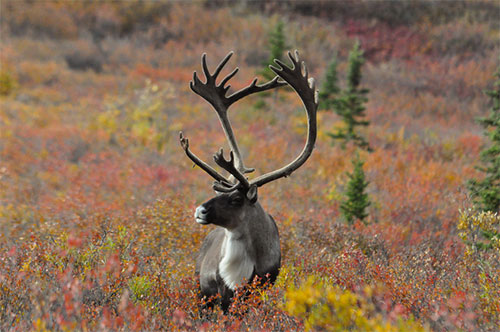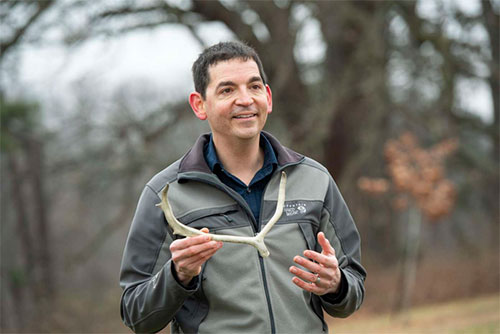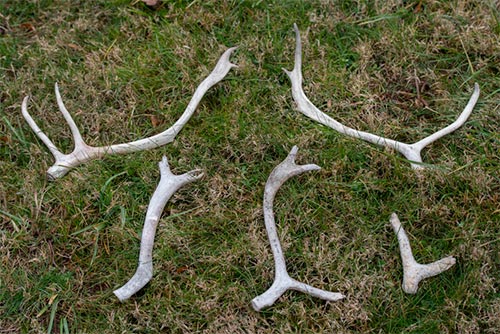Alaska's barren-ground caribou have been using the same parts of the Arctic National Wildlife Refuge to give birth to their calves for at least 3,000 years, according to researchers. |
He has been leading summer expeditions to the Arctic National Wildlife Refuge since 2010, using rafts to navigate remote rivers to search for caribou antlers exposed on the tundra.
“We think about having to dig down into the soil to find that kind of ecological history, but on the Coastal Plain, the vegetation grows extremely slowly,” Miller said. “Bones dropped by animals that lived dozens or even hundreds of generations in the past can provide really meaningful information.”
The study demonstrates how important the area is for an animal that native Alaskans and Candians still depend on for sustenance, even as energy companies seek to exploit oil and gas resources in this protected area.
The Biden Administration in 2021 suspended drilling leases in the Arctic National Wildlife Refuge, the largest tract of undeveloped wilderness in the United States.
“We know this region of the Arctic National Wildlife Refuge has been an important area for caribou for millennia,” Miller said. “That should give us pause on how we think about those landscapes.”
The study was published in the journal Frontiers in Ecology and Evolution.
University of Cincinnati assistant professor Joshua Miller holds an antler shed by a female caribou in the Arctic National Wildlife Refuge. By conducting an isotopic analysis of the antler, researchers can track the animal's migration over the previous year. |
Barren ground caribou undertake nature’s longest overland migration, traveling as far as 800 miles each year to reach their spring calving grounds in the Arctic National Wildlife Refuge and Canada’s Ivvavik National Park. The largest herd in this area, named for the Porcupine River, numbers in the hundreds of thousands of animals.
Scientists think caribou use these areas because they have fewer predators and offer seasonal vegetation near places where they can avoid the worst of the mosquitoes.
“The mosquitoes are horrible,” Miller said. “You get swarmed — literally covered in them. They can do significant damage to a young calf.”
Whatever the reason, the antlers they leave behind provide a physical record of their epic yearly travels that researchers can unlock through isotopic analysis.
Caribou antlers, like those of elk, deer and moose, are made of fast-growing bone that the animals shed each year and regrow the following year.
“It is amazing to think that the oldest of the antlers found in our study were growing approximately the same time Homer was penning ‘the Iliad’ and ‘the Odyssey,’” study co-author Patrick Druckenmiller said.
He is director of the University of Alaska Museum and professor of the Department of Geology and Geophysics at the University of Alaska Fairbanks. Eric Wald from the U.S. Fish and Wildlife Service also co-authored the study.
The antler surveys in the vast expanse of the Arctic refuge require meticulous logistical planning, Miller said. Small planes deposit researchers and their gear deep in the interior, where they have to be watchful for grizzly and polar bears. They pilot rafts to the Beaufort Sea, conducting a grid search of suitable caribou habitat identified in advance using aerial photography.
By comparing isotopes in shed antlers to the geology of Alaska, researchers can tell where caribou have spent the year feeding. |
“We search for antlers along old river terraces, walking back and forth, covering every inch of habitat to find those ancient treasures,” Miller said.
While male caribou antlers span four feet and weigh more than 20 pounds, female caribou antlers are much smaller. The antlers contain nutrients such as phosphorus and calcium that are important to plants and animals.
The dropped antlers create “nutrient sinks,” which could have a profound effect on the area’s vegetation. Miller said the caribou’s migration serves as a nutrient “conveyor belt” that might even draw caribou back to reap the benefits of this fertilizer in a reinforcement loop.
Caribou and other mammals are known to chew on dropped antlers for their valuable minerals. This could be an important dietary supplement for new caribou moms.
“We’d like to know to what degree this conveyor belt influences why caribou are going there in the first place,” Miller said.
The study was supported by the U.S. Fish and Wildlife Service, the National Geographic Society, the National Science Foundation, the Wildlife Society and the UC Office of Research.
Miller said the Arctic is warming faster than other parts of the globe. Parts of the Arctic that were once barren tundra are sprouting new spruce forests.
“We were in Arctic Village this summer, just south of the calving grounds, talking to elders about the changes they have seen,” Miller said. “Where once it was open tundra, large stretches of this barren ground are now full of trees everywhere. What will happen to the barren ground caribou as this habitat gets converted into forest?”
On the Web:
Journal: Frontiers in Ecology and Evolution
Shed female caribou antlers extend records of calving activity on the Arctic National Wildlife Refuge by millenniaFunding source: National Geographic Society, National Science Foundation, The University of Cincinnati Office of Research, U.S. Fish and Wildlife Service
Edited by Mary Kauffman, SitNews
Source of News:
University of Cincinnati
www.uc.edu
Representations of fact and opinions in comments posted are solely those of the individual posters and do not represent the opinions of Sitnews.
Send a letter to the editor@sitnews.us
SitNews ©2023
Stories In The News
Ketchikan, Alaska
Articles & photographs that appear in SitNews are considered protected by copyright and may not be reprinted without written permission from and payment of any required fees to the proper freelance writers and subscription services.
E-mail your news & photos to editor@sitnews.us
Photographers choosing to submit photographs for publication to SitNews are in doing so granting their permission for publication and for archiving. SitNews does not sell photographs. All requests for purchasing a photograph will be emailed to the photographer.



